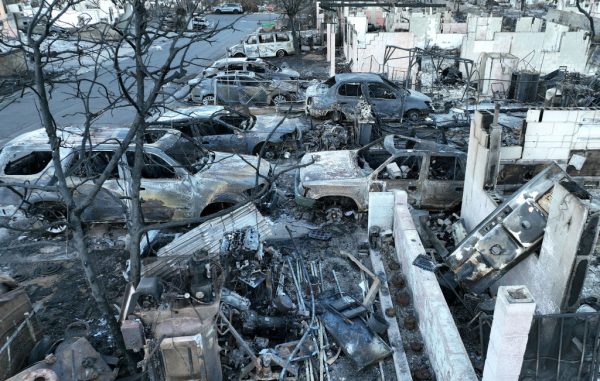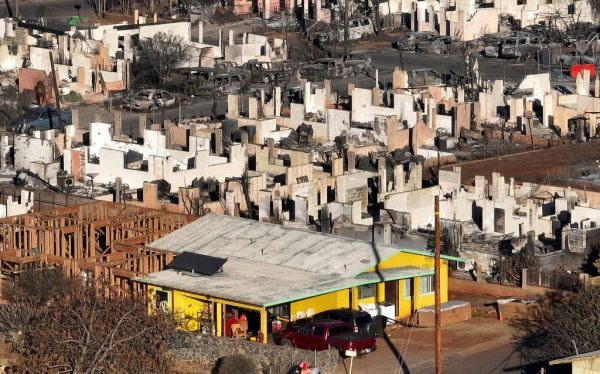Beginning Aug. 8, the idyllic island paradise of West Maui found itself grappling with an unprecedented crisis as multiple wildfires ignited simultaneously that nearly completely wiped out the historic town of Lahaina. As of Aug. 17, officials said three fires were still raging, scorching an estimated area of 5.7 square miles.
Amid the tragedy, which has claimed 111 lives as of Aug. 16, destroyed over 2,000 properties, and left thousands still unaccounted for, Hawaii Gov. Josh Green (D) has shed light on how certain individuals and businesses are trying to take advantage of the chaos to swoop in and snatch up land in the area.
MORE ON THIS: Maui Wildfires Claim Over 110 Lives, Leaving Thousands Homeless as Rescue Efforts Continue
‘Maui is not for sale’
During a video call on Aug. 15, Green made a clarion call to mainland U.S. developers and international investors. His message was clear: Steer clear of purchasing the scorched lands in the aftermath of this tragedy. “Maui is not for sale,” he said.
Through Gov. Green’s interventions, residents of Lahaina are hoping the state government will continue to protect them against prying developers as they evaluate the aftermath of the devastated land and gauge how much capital reconstruction efforts will require. “It’s imperative that we shield our ancestral lands and ensure that they don’t fall into the hands of external parties who might not cherish its deep-rooted significance,” Green said.
Success
You are now signed up for our newsletter
Success
Check your email to complete sign up
After decimating nearly 90 percent of residential properties in the area, Green said in a briefing on Aug. 13 that clean up and rebuilding efforts will take years to complete. “This is the largest natural disaster we’ve ever experienced. Recovery will require an incredible amount of time.”
Aftermath
On Aug. 16, official reports upped the death toll to 111, with countless more rendered homeless, and estimated the loss of property value at $5.6 billion. While search and rescue efforts are underway and could take weeks to complete, Gov. Green said it is “impossible” to estimate what the final death count will be.
In response, Green is not just limiting his actions to words of caution. He’s already initiated dialogues with the state attorney general to discuss the feasibility of a sales moratorium on the lands scarred by the fires.

“We will be making sure that we do all that we can to prevent that land from falling into hands of people from the outside. It’s not easy to do in some cases,” Green said during the call. “But you can be sure I will not be allowing anyone to build, re-zone, or do anything of that sort if they’ve taken advantage of anyone here.”
In addition, affected locals need to be educated on their land rights during these trying times, said Green, noting that legal experts would be stationed at response centers and working pro bono to help locals understand what their rights are.
“Their mission is to offer guidance, free of charge, to our residents to make sure they aren’t being manipulated or bullied by opportunistic land buyers,” said Green.
More than just land
To a casual observer, Lahaina might seem like any other picturesque town in Hawaii, featuring stunning ocean views and white sandy shores. But dig a little deeper, and its rich tapestry of history unfolds. With a population hovering around 13,000, Lahaina boasts of a storied past that resonates with Hawaii’s native cultural history.
The town’s significance is amplified by the fact that it was once the bustling capital of Hawaii during the early 19th century. This was a time when Hawaii proudly stood as an independent kingdom, untouched by external political influences. Although the seat of power transitioned to Honolulu by 1850, a few decades before the U.S. formally annexed the islands in 1898, Lahaina’s historical essence remains intact.

While the wildfires may have physically razed homes, they haven’t dented the indomitable spirit and resilience of Lahaina’s residents.
Tammy Kaililaau’s tale is emblematic of this resilience. Having seen her cherished home of two decades reduced to cinders, she was incredulous when developers reached out with purchase offers in the immediate aftermath of the tragedy.
“Why are they doing that? You know, people burned in the fires,” said Kaililaau in a video posted to social media on Aug. 12, referring to the opportunistic land buyers. “It’s hard. It’s rough, really, really rough,” she can be heard saying in the video.
John Dimuro, another Lahaina resident, has called West Maui home for the past four decades. He shared a similar sentiment — emphasizing that locals are wary of corporations or affluent investors altering the essence of their already rapidly gentrifying community.
“The government should just say ‘No, you’re not allowed to develop,'” he said. “Say no, just flat-out no.”
For Mark Stefl, another resident, Lahaina is more than just a piece of property. Despite suffering losses in previous disasters, his resolve to rebuild stands testament to his love for the land.
“Lahaina, with all its challenges, is home. I’m here to stay, rebuild, and cherish the memories,” he told USA Today. “I’m not going to sell it. I’m going to stay here,” he said. “I love it here, as messed up as it is.”
Lahaina’s socio-economic challenges
The tragedy has amplified pre-existing socio-economic challenges in Lahaina. Hawaii’s high cost of living and its persistent housing shortages have been thorns in its residents’ sides for years now, experts say. Reports from 2022 highlighted Hawaii as having the highest living expenses in the U.S., coupled with the fourth highest homelessness rate.
Yet, in the face of adversity, help has begun to pour in. Initiatives to support the displaced are already underway. Over 1,000 free hotel rooms were provided by Airbnb, in addition to 435 donated units and other forms of accommodation to help affected individuals rebuild the community.
In addition, the federal government has also vowed to provide emergency support to the impacted areas after President Joe Biden declared Hawaii a disaster zone on Aug. 14, thus facilitating vital emergency resources.
“I remain committed to delivering everything the people of Hawai’i need as they recover from this disaster,” Biden wrote on X, the social media platform formerly known as Twitter.
Looking ahead
While the immediate challenges of recovery loom large, the collective spirit of Lahaina’s residents offers a beacon of hope.
Jonah Lion, a local businessman, encapsulated this sentiment by sharing with USA Today that nothing can replace the deeply rooted significance of these lands. “Generations of our ancestors have lived and thrived here. No monetary offer can replace the emotional and cultural significance of our lands,” he said.
While the road to recovery will be long and filled with challenges, Lahaina’s residents have made it abundantly clear: their land, heritage, and future are not up for negotiation.
















